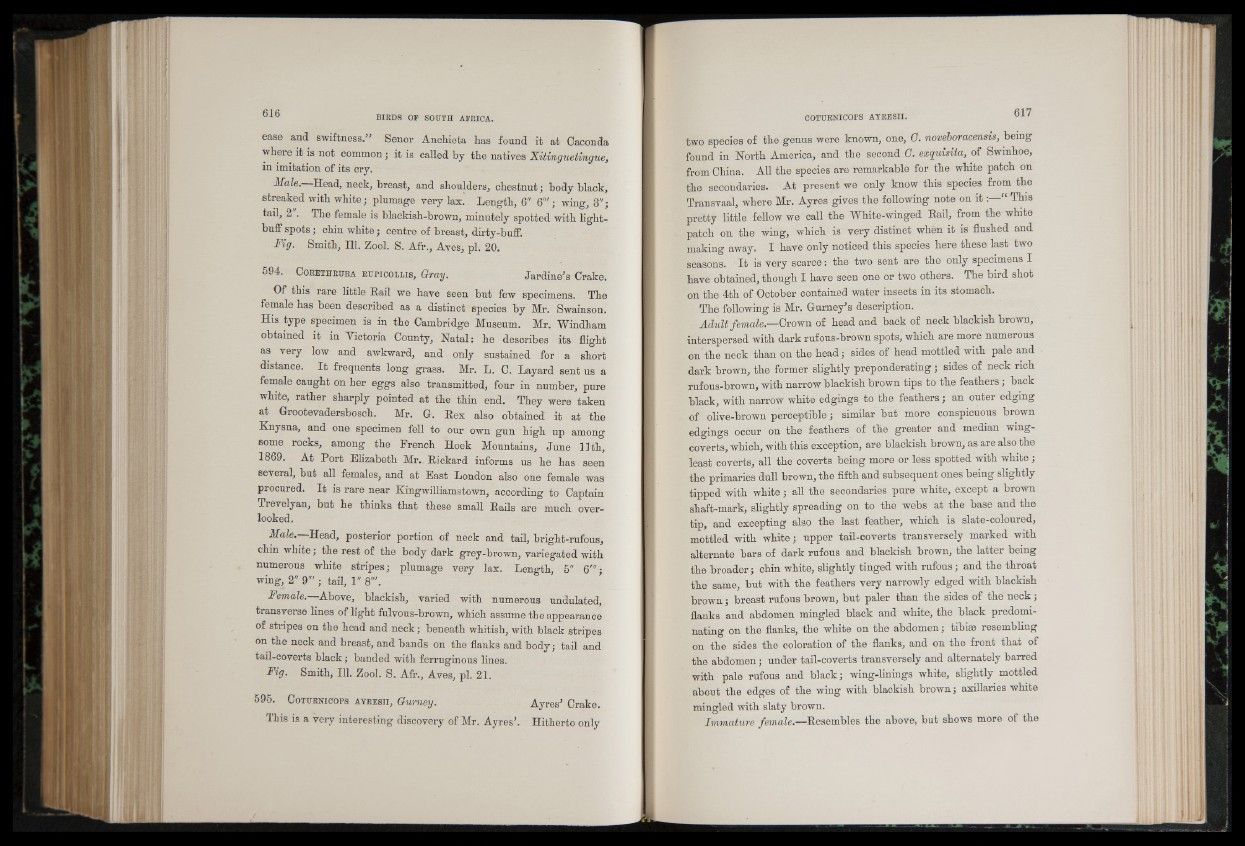
ease and swiftness.” Senor Anchieta has found it at Caconda
where it is not common; it is called by the natives Xitinguetingue,
in imitation of its cry.
Male.—Head, neck, breast, and shoulders, chestnut; body black,
streaked with white; plumage very lax. Length, 6" 6"'; wing, 3";
tail, 2 '. The female is blackish-brown, minutely spotted with light-
buff spots; chin white; centre of breast, dirty-buff.
Fig. Smith, 111. Zool. S. Afr., Aves, pi. 20.
694. C o r e th r ttr a RUPicoLLis, Gray. Ja rdW s Crake.
Of this rare little Rail we have seen but few specimens. The
female has been described as a distinct species by Mr. Swainson.
His type specimen is in the Cambridge Museum. Mr. Windham
obtained it in Victoria County, Natal: he describes its flight
as very low and awkward, and only sustained for a short
distance. I t frequents long grass. Mr. L. C. Layard sent us a
female caught on her eggs also transmitted, four in number, pure
white, rather sharply pointed at the thin end. They were taken
at Grootevadersbosch. Mr. G. Rex also obtained it at the
Knysna, and one specimen fell to our own gun high up among
some rocks, among the French Hoek Mountains, June 11th,
1869. At Port Elizabeth Mr.. Rickard informs us he has seen
several, but all females, and at East London also one female was
procured. It is rare near Kingwilliamstown, according to Captain
Trevelyan, but he thinks that these small Rails are much overlooked.
Male.—Head, posterior portion of neck and tail, bright-rufous,
chin white; the rest of the body dark grey-brown, variegated with
numerous white stripes; plumage very lax. Length, 5" 6"';
wing, 2" 9'" ; tail, 1" 8'".
Female. Above, blackish, varied with numerous undulated,
transverse lines of light fulvous-brown, which assume the appearance
of stripes on the head and neck; beneath whitish, with black stripes
on the neck and breast, and bands on the flanks and body; tail and
tafl-coverts black; banded with ferruginous lines.
Fig. Smith, 111. Zool. S. Afr., Aves, pi. 21.
596. C oturnicofs a y r e s ii, Gurney. Ayres' Crake.
This is a very interesting discovery of Mr. Ayres'. Hitherto only
two species of the genus were known, one, 0. noveboracensis, being
found in North America, and the second G. exquisita, of Swinhoe,
from China. All the species are remarkable for the white patch on
the secondaries. At present we only know this species from the
Transvaal, where Mr. Ayres gives the following note on i t : “ This
pretty little fellow we call the White-winged Rail, from the white
patch on the wing, which is very distinct when it is flushed and
making away. I have only noticed this species here these last two
seasons. I t is very scarce: the two sent are the only specimens I
have obtained, though I have seen one or two others. The bird shot
on the 4th of October contained water insects in its stomach.
The following is Mr. Gurney's description.
Adult female.—Crown of head and back of neck blackish brown,
interspersed with dark rufous-brown spots, which are more numerous
on the neck than on the head; sides of head mottled with pale and
dark brown, the former slightly preponderating; sides of neck rich
rufous-brown, with narrow blackish brown tips to the feathers; back
black, with narrow white edgings to the feathers; an outer edging
of olive-brown perceptible; similar but more conspicuous brown
edgings occur on the feathers of the greater and median wing-
coverts, which, with this exception, are blackish brown, as are also the
least coverts, all the coverts being more or less spotted with white;
the primaries dull brown, the fifth and subsequent ones being slightly
tipped with white; all the secondaries pure white, except a brown
shaft-mark, slightly spreading on to the webs at the base and the
tip, and excepting also the last feather, which is slate-coloured,
mottled with white; upper tail-coverts transversely marked with
alternate bars of dark rufous and blackish brown, the latter being
the broader; chin white, slightly tinged with rufous; and the throat
the same, but with the feathers very narrowly edged with blackish
brown; breast rufous brown, but paler than the sides of the neck;
flanks and abdomen mingled black and white, the black predominating
on the flanks, the white on the abdomen; tibise resembling
on the sides the coloration of the flanks, and on the front that of
the abdomen; under tail-coverts transversely and alternately barred
with pale rufous and black; wing-linings white, slightly mottled
about the edges of the wing with blackish brown; axillaries white
mingled with slaty brown.
Immature female.—Resembles the above, but shows more of the